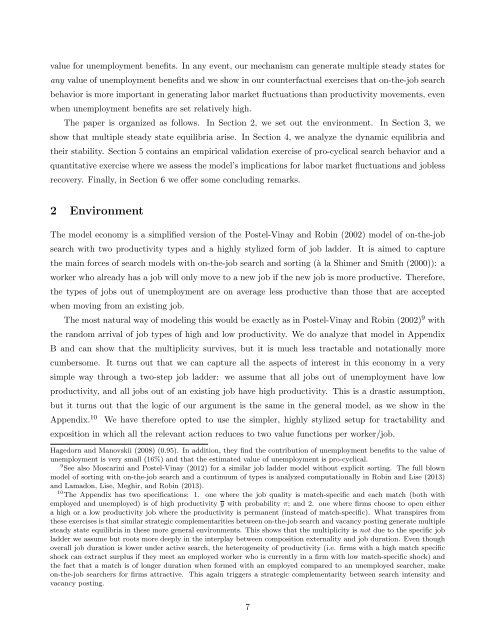Unemployment cycles
WP201526
WP201526
You also want an ePaper? Increase the reach of your titles
YUMPU automatically turns print PDFs into web optimized ePapers that Google loves.
value for unemployment benefits. In any event, our mechanism can generate multiple steady states for<br />
any value of unemployment benefits and we show in our counterfactual exercises that on-the-job search<br />
behavior is more important in generating labor market fluctuations than productivity movements, even<br />
when unemployment benefits are set relatively high.<br />
The paper is organized as follows. In Section 2, we set out the environment. In Section 3, we<br />
show that multiple steady state equilibria arise. In Section 4, we analyze the dynamic equilibria and<br />
their stability. Section 5 contains an empirical validation exercise of pro-cyclical search behavior and a<br />
quantitative exercise where we assess the model’s implications for labor market fluctuations and jobless<br />
recovery. Finally, in Section 6 we offer some concluding remarks.<br />
2 Environment<br />
The model economy is a simplified version of the Postel-Vinay and Robin (2002) model of on-the-job<br />
search with two productivity types and a highly stylized form of job ladder. It is aimed to capture<br />
the main forces of search models with on-the-job search and sorting (à la Shimer and Smith (2000)): a<br />
worker who already has a job will only move to a new job if the new job is more productive. Therefore,<br />
the types of jobs out of unemployment are on average less productive than those that are accepted<br />
when moving from an existing job.<br />
The most natural way of modeling this would be exactly as in Postel-Vinay and Robin (2002) 9 with<br />
the random arrival of job types of high and low productivity. We do analyze that model in Appendix<br />
B and can show that the multiplicity survives, but it is much less tractable and notationally more<br />
cumbersome. It turns out that we can capture all the aspects of interest in this economy in a very<br />
simple way through a two-step job ladder: we assume that all jobs out of unemployment have low<br />
productivity, and all jobs out of an existing job have high productivity. This is a drastic assumption,<br />
but it turns out that the logic of our argument is the same in the general model, as we show in the<br />
Appendix. 10<br />
We have therefore opted to use the simpler, highly stylized setup for tractability and<br />
exposition in which all the relevant action reduces to two value functions per worker/job.<br />
Hagedorn and Manovskii (2008) (0.95). In addition, they find the contribution of unemployment benefits to the value of<br />
unemployment is very small (16%) and that the estimated value of unemployment is pro-cyclical.<br />
9 See also Moscarini and Postel-Vinay (2012) for a similar job ladder model without explicit sorting. The full blown<br />
model of sorting with on-the-job search and a continuum of types is analyzed computationally in Robin and Lise (2013)<br />
and Lamadon, Lise, Meghir, and Robin (2013).<br />
10 The Appendix has two specifications: 1. one where the job quality is match-specific and each match (both with<br />
employed and unemployed) is of high productivity y with probability π; and 2. one where firms choose to open either<br />
a high or a low productivity job where the productivity is permanent (instead of match-specific). What transpires from<br />
these exercises is that similar strategic complementarities between on-the-job search and vacancy posting generate multiple<br />
steady state equilibria in these more general environments. This shows that the multiplicity is not due to the specific job<br />
ladder we assume but roots more deeply in the interplay between composition externality and job duration. Even though<br />
overall job duration is lower under active search, the heterogeneity of productivity (i.e. firms with a high match specific<br />
shock can extract surplus if they meet an employed worker who is currently in a firm with low match-specific shock) and<br />
the fact that a match is of longer duration when formed with an employed compared to an unemployed searcher, make<br />
on-the-job searchers for firms attractive. This again triggers a strategic complementarity between search intensity and<br />
vacancy posting.<br />
7


